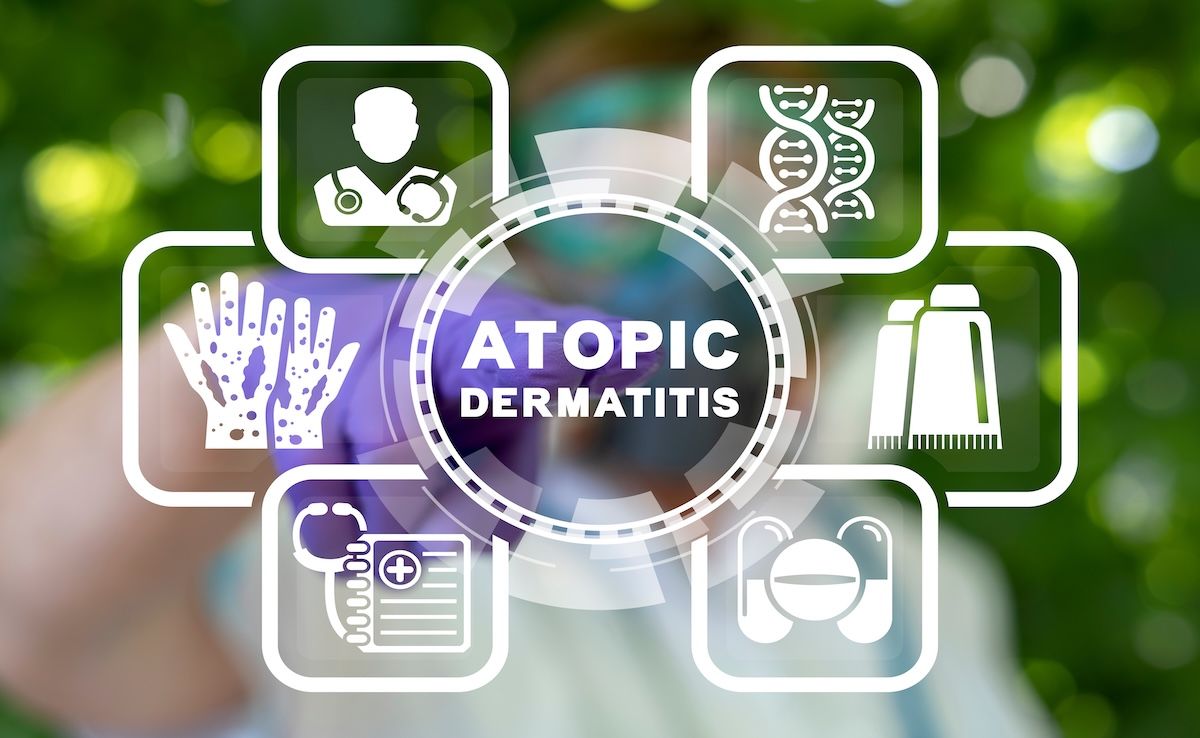Of the 181 patients with atopic dermatitis in the ADjoin trial (NCT04392154), 50% were able to maintain long-term skin clearance from using lebrikizumab (Ebglyss; Lilly) out to 3 years, or 152 weeks, according to data presented at the recent Society for Pediatric Dermatology Annual Meeting.1
Additional findings of note in the long-term extension (LTE) analysis are that patients who received 250-mg lebrikizumab every 2 weeks (n = 82) or every 4 weeks (n = 99) achieved EASI-90, at 79.4% and 86.8%, respectively, and that 49.2% and 50.0% achieved EASI-100.
ADjoin is the LTE analysis of deep response maintenance and quality of life in patients originally enrolled in the ADvocate 1 trial (NCT04146363) and the ADvocate 2 trial (NCT04178967). In these trials, the primary outcomes measured from baseline to week 16 were percentage of participants with an Investigator Global Assessment (IGA) Score of 0 or 1 and a reduction of at least 2 points as well as percentage of participants achieving Eczema Area and Severity Index (EASI-75; ≥75% reduction in EASI score).2-3 Both were randomized, double-blind, placebo-controlled, parallel-group analyses vs the LTE analysis in which participants are blinded or not blinded according to their parent study assignment.2-4
Baseline characteristics varied between the original analyses and the LTE study. Mean (SD) ages, EASI and Patient-Oriented Eczema Measure (POEM) scores, disease duration, body mass index, and percentage of patients from Europe were close to equal; however, the LTE study had fewer adolescent and female patients, as well as participants from the US and the rest of the world.
The interleukin-13 receptor inhibitor that is also a monoclonal antibody administered subcutaneously was effective over the long term in patients with atopic dermatitis on maintenance therapy. | Image Credit: © wladimir1804-stock.adobe.com
Overall, in addition to the results above, the following significant patient improvements were seen with 3 continuous years of treatment (52 weeks in the original trials through 152 weeks in the extension trial):
- Despite response rates that varied for both doses (250 mg every 2 weeks or every 4 weeks) from week 52 to week 104, continuous improvement was seen in IGA 0 response rates at the every-2-weeks 250-mg dose of lebrikizumab for weeks 104 through 152 while response to the every-2-weeks 250-mg dose peaked at week 128
- EASI-90 rates were consistently high for the duration of the LTE analysis, ranging from 78.4% to 79.4% for the every-2-weeks dose and 78.2% to 86.8% for the every-4-weeks dose
- EASI-100 rates were also consistently high, but demonstrated significantly greater improvement from week 52 through week 152 compared with EASI-90: total patients achieving this milestone rose from 36.4% to 49.2% in those on the every-2-weeks dose and from 30.7% to 50.0% in those on the every-4-weeks dose
Need for rescue therapy was also investigated, with this treatment used concomitantly during the treatment period. Totals of 96% of patients receiving 250-mg lebrikizumab every 2 weeks and 91% every 4 weeks did not require any systemic rescue treatment; 94% and 95%, respectively, did not require topical calcineurin inhibitors at any point; and 90% and 86% did not require any topical corticosteroids during the LTE analysis.
POEM scores were either maintained or improved for both patient groups throughout the extension study period. In the every-2-weeks group, total patients responding rose from 20.5% to 24.0%, and from 18.8% to 32.7% in the every-4-weeks group.
To be included in the LTE analysis, patients had to complete either of the parent studies and the last patient visit in those trials; they were excluded from the LTE analysis if they experienced a serious adverse event that led to treatment discontinuation or if they met conditions for discontinuation according to the investigator or sponsor, which included noncompliance and incomplete study assessments.
“These 3-year data suggest that long-term maintenance of total skin clearance is an achievable treatment goal for at least half of lebrikizumab week 16 monotherapy responders,” the study authors concluded.
References
- Simpson E, Biedermann T, Kircik L, et al. Raising the bar of efficacy in atopic dermatitis: lebrikizumab maintains depth of response over 3 years in week 16 responders. Presented at: Society for Pediatric Dermatology Annual Meeting; July 23-26, 2025; Seattle, WA. Poster POS-11.
- Evaluation of the efficacy and safety of lebrikizumab (LY3650150) in moderate to severe atopic dermatitis (ADvocate1). ClinicalTrials.gov. Updated November 30, 2022. Accessed August 5, 2025. https://clinicaltrials.gov/study/NCT04146363
- Evaluation of the efficacy and safety of lebrikizumab (LY3650150) in moderate to severe atopic dermatitis (Advocate2). ClinicalTrials.gov. Updated May 24, 2023. Accessed August 5, 2025. https://clinicaltrials.gov/study/NCT04178967
- Long-term safety and efficacy study of lebrikizumab (LY3650150) in participants with moderate-to-severe atopic dermatitis (ADjoin). ClinicalTrials.gov. Updated August 3, 2025. Accessed August 5, 2025. https://clinicaltrials.gov/study/NCT04392154
